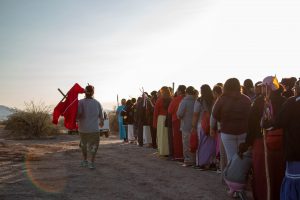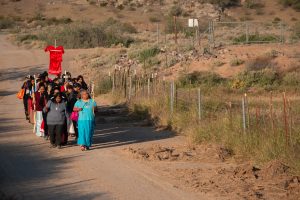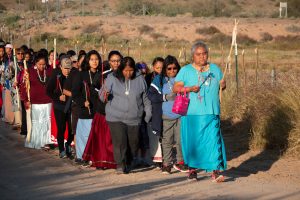- Slug: BC-CNS-Prayer Run. 1,340 words.
- Photos and captions below.
By Carly Henry
Cronkite News
BAPCHULE — The sun rose into a violet-tinted sky as dozens of O’odham and Piipaash women prepared to leave for the last leg of a 53-mile journey spent in prayer for missing and murdered indigenous women.
The two-day relay run, one of a number of events this year focused on bringing attention to the disproportionate rates of violence against indigenous people, took place days before the release of a report that found Arizona has the third highest number of such cases involving indigenous women.
The report, published by the Urban Indian Health Institute, found that of 5,712 indigenous women reported missing in 2016, only 116 were logged into the Department of Justice’s federal missing persons database. Recent studies, which show trends many people within indigenous communities have been long aware of, have drawn further attention to the crisis.
“For far too long, we’ve seen these stories be well-known but usually swept under the rug,” said Renee Jackson, who says the idea for the Women’s Prayer Run came to her in a dream. “By bearing those secrets or stories, it causes a great illness within our communities.”
Healing starts with the blessing of rivers
The Women’s Prayer Run, which has taken place annually since 2014, focuses on a different prayer every year. The first year focused on the burdens women face as the backbone of their families.
“The run’s focused prayer this year was not only about acknowledging the violence that lives in our community and sometimes in our bones and our skin – of the pain that’s been inflicted on us and the healing that needs to take place,” Jackson said. “But also to remember that we have to speak for other women, sisters, who aren’t here anymore.”
Jackson said choosing to focus on violence against indigenous people felt right for this year’s run, which started in Laveen and ended Sunday in Coolidge. She recalled hearing stories from women of all ages about how violence had personally impacted them.
Running holds significance within the Tohono O’odham community, where it was traditionally used as a form of practical communication and time to pray, Jackson said.
The run officially began Saturday at the convergence of the Salt and Gila rivers, where women blessed themselves in water. From there, the two-day route took women along streets and dirt trails, past fields, saguaros and creosote blooming with tiny yellow flowers.
In pairs, women carried the group’s coikud, a staff once commonly used to help women support the weight of supplies they gathered – symbolic of the burdens they carry today.
The first day ended at Aji Mountain, a spot near Bapchule adorned with desert brush and saguaros.
‘I wasn’t sure I could make it through’
Early the next day, runners – many of them wearing skirts known as i:puds in O’odham culture – prepared to get back on the route.
Rebecca Moffett wore a blue dress, braided hair and a seashell necklace as she led the group out of their Aji Mountain campsite. She later said going on the run made her feel more powerful.
“I wasn’t sure at the beginning if I would make it through, but I made it through both days,” Moffett said. “I feel strong.”
The cause is personal for Moffett. When she was 23, she was shot in the chest by someone close to her. Her physical wounds healed. She stayed with the shooter.
After several years, Moffett walked away.
“I just got stronger and wasn’t going to do it anymore,” said Moffett, who ran with her daughter, Breedra Lewis, 18. “I hope younger women never have to deal with that.”
Many of the women running shared a common pain: Their families all had been touched by violence.
Margaret Johnson has been to four Prayer Runs. She considers them part of her spiritual food.
Like others, the runs are personal for Johnson, who’s raising her sister’s three children. Her sister was in an abusive relationship and died 10 years ago, she said.
The run also lets Johnson share her story of sobriety. Once a victim of alcohol and meth, she now has been sober nine years. She said she owes her new life to Jesus.
“No matter how far down you go go, he will bring you back up,” she said, stretching her hands to the sky.
The run was about gaining strength from one another.
Denise Jackson found restoration the two times she has run. Before to her first run, Jackson, a mother of seven, had started to lose sight of who she was outside of her relationships.
“My first time was about finding myself as me,” Jackson said. “Not a mom, not a wife, not a friend.”
Pushing herself out of her comfort zone helped Jackson feel at ease with herself.
This time, she brought her five daughters to the run with her. Focused prayer against violence brought back memories of seeing people near her experience domestic violence, something she knew she didn’t want for her own children.
“I didn’t want my daughters to experience that and I didn’t want my sons to become like that and vice-versa,” Jackson said. “I wanted to stop the cycle.”
Research shows alarming rates of violence
Four out of five indigenous people in the U.S. experience violence in their lifetime, according to a 2016 report funded by the National Institute of Justice.
Recent efforts to combat the high rates of violence experienced by women in indigenous communities have focused on giving tribes greater ability to prosecute non-Native people who commit crimes on native lands. But that push to study and decrease crime on native lands could be overshadowing crimes committed against indigenous people off reservations, according to the Urban Indian Health report.
About 71 percent of native people live in urban areas, but most major studies have focused on crimes committed on native lands, according to the UIHI report and an Arizona State University researcher.
Cheryl Bennett, an associate professor of American Indian Studies at ASU who researches crime against indigenous people, said the institute report supported her own research on cases of missing and murdered indigenous women in the Southwest: Many crimes against indigenous women are committed outside tribal lands.
The report found that 54 of the 506 cases it found of missing and murdered indigenous women living in urban areas — which it considers to be an undercount — took place in Arizona.
“A lot is happening off-reservation,” Bennett said, “and if that’s the case, then we need to advocate, not just for VAWA and those types of laws, but for laws and things we can do off-reservation.”
The landmark Violence Against Women Act was reauthorized in 2013 and gave tribes more authority to prosecute non-Natives in situations of domestic violence.
As efforts to raise awareness gain national traction, Bennett hopes to see action.
“I think it’s hopeful that there’s been a lot of conversation around these issues, but my concern is that I don’t want it to be the next fad,” she said.
The run ends but the cause continues
People along the route cheered the runners and support vehicles following them. The women eventually found themselves on a mountainous desert trail only suitable for four-wheelers and trucks. The Women’s Prayer Run ended with a cornmeal offering at a sacred site near Coolidge.
Supporters and organizers took women to a nearby community center for closing thoughts and a shared meal with family and friends.
After two days and 53 miles of running across Native land, women and their families filled a community gym with smiles and conversation.
Jackson said the run created an avenue for discussion about violence against indigenous people, not only within the Gila River community but around the country. She hopes other indigenous communities notice O’odham solidarity over the missing and murdered indigenous women movement.
“Our intention is for us to make a visible effort to show other women in other indigenous communities that we support them and that our prayers extend, not only to our community, but to theirs, too,” Jackson said.
Connect with us on Facebook.
For more stories from Cronkite News, visit cronkitenews.azpbs.org.
^_=



